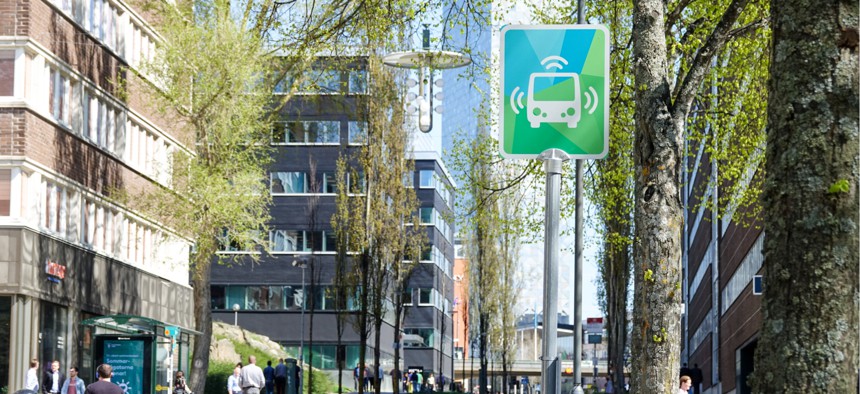Self-Driving Cars Aren’t Going To Fix Our Roadways

Bus stop for autonomous vehicles in Stockholm, Sweden. Shutterstock.com
COMMENTARY | Automated vehicles aren't going to make it solo. Humans and machines alike are going to need connected infrastructure to tame our transportation future.
There are a lot of myths around driving’s past, present and future. One common misconception is that we humans are actually good at it. A second, emerging myth is that autonomous vehicle technology alone will be the safety panacea that will save the American roadway.
As many of my fellow commuters might suspect, humans are not actually great at driving. In fact, we are simply more willing to take risks. Human drivers faced with navigating a busy left hand turn will eventually pull the trigger, even if it is not safe to proceed.
We have a frustration slide scale that builds the longer we are asked to wait. For the first couple seconds of delay, safety makes us cautious. But as our wait time increases, there is a corresponding decrease in our patience. At some point, we willingly trade safety for efficiency and make dangerous moves. Mostly this works out: other drivers will give a little, and often we were overly cautious to start with. However, when we make mistakes, the results are often deadly.
A 2009 study suggests that 42 percent of motorcycle accidents occur at intersections when drivers make unprotected turns across oncoming bikers the drivers did not see. In total, there were 37,133 traffic related deaths in the U.S. in 2017. Traffic accidents account for almost 25 percent of deaths for people aged 15 to 24 in the U.S.
Clearly, there is a huge problem with our driving. As a culture, we have largely come to accept these risks. But how much leeway are we willing to give computers in making these types of trade-offs on our behalf?
At present, very little. In March of 2018, an autonomous Uber test vehicle struck and killed a pedestrian in Tempe, Arizona. The public reaction was swift and brutal. Uber was sharply, and rightly criticized for trading down safety. But this is ironically what human drivers do every day in every city in the world—even AV safety drivers. Last October a Waymo vehicle collided with a motorcycle after the safety driver took manual control in order to help the AV navigate a lane change (Waymo claims the computer was hesitant precisely because it saw the motorcycle).
And the reality of AV tech is—despite incredible advances—there remain some fundamental hurdles. A few use cases pose particular challenges for AVs: unprotected left hand turns, lane changes in heavy traffic, obstructed lines of sight and traffic signal timing.
In recent testing, Uber’s AV fleet “needed to drive 20 percent slower to match the reaction time of a human driver at 25 mph”. Despite many years head start and millions of testing miles in development advantage, Waymo vehicles still feel frustratingly hesitant when making unprotected left hand turns.
So long as software is tasked with proving a negative (that no obstacle exists in the vehicle’s path of travel) there will always be accidents. Vehicles, like humans, can only see so much. It is very hard to know if you don’t see a pedestrian because there is no pedestrian, or because they are simply out of view around a corner or behind another object (or hidden in a sensor glitch).
These limitations are serious—88 percent of AV crashes reported to the California DMV between 2014 and 2018 occurred at traffic signals—and no amount of on-vehicle tech can ever fully solve this issue.
Evidence increasingly shows that connected infrastructure is the critical last piece of the AV puzzle.
Instead of relying exclusively on vehicle sensors to understand their surroundings, safe AVs should also be listening to the infrastructure itself. Connected infrastructure comes in several flavors, but at a minimum consists of arrays of sensors at the street level that gather data about passing road users combined with some method of communicating that data. More advanced systems employ software algorithms (AI) to analyze the data for intelligence like near misses, impending collisions, and changes in travel demand. Recently, technology is emerging that completes the loop by feeding that intelligence back into both vehicles and infrastructure in actionable ways.
For example, traffic signal sensors have long detected vehicle presence. Today, that detection is increasingly coupled with AI that assesses the probability of things like red-light violations, in real time, and then uses those estimates to actually change signal behavior. In this example, the signal might delay switching to a green light for vehicles that would cross in front of a red-light runner so that the intersection is kept clear and a collision prevented.
There are many use cases, but the takeaway is that this kind of vehicle-to-infrastructure (known as V2X) communication can augment AVs and human drivers’ awareness alike in ways that dramatically reduce the cost of mistakes. Most vehicle manufacturers and major parts suppliers are reaching the same conclusion and a vast development effort is underway to deploy advanced connected infrastructure quickly in order to pave the way for connected and autonomous vehicles.
As a result, the pace of related pilot projects has increased. GM, Audi, and Honda, for example, all have active projects running in various cities in both the U.S. and abroad to help them design best practices around V2X systems. In addition, the pace of company partnerships and startup acquisitions in this space has also picked up dramatically as large players scrambled to augment their AV efforts.
This market activity creates both challenges and opportunities for municipalities and DOTs. As the number of pilot projects increase, opportunities for forward looking cities to help shape the AV landscape are abundant. The challenges are in figuring out how to prevent fleet operators from taking shortcuts on safety that harm citizens and in ensuring that citizens are the primary beneficiaries of publicly funded transportation infrastructure.
Finally, there are ever-present security considerations that cities must take into account. Like any software system, AV networks can potentially be breached or misused by bad actors. Connected infrastructure systems are typically firewalled behind traffic signal conflict monitors that are hardwired to limit the havoc that can be created if hacked. AVs have no such protection because they are physically moving on streets. Connected infrastructure can provide a critical safety check on AV fleets by providing secondary confirmation about vehicle identity and activity.
For example, V2X is often cited as a way to allow emergency vehicles priority access to green lights. However, such devices could be stolen or spoofed giving hackers similar priority. Visual confirmation from a connected sensor can ensure that all calls for priority green are coming from appropriately authorized vehicles at appropriate times; misuse or errors are quickly detected. A rapid response is likely the best way to minimize the harm from AV problems—whether a connected vehicle hack or sensor failure. These verification systems should be an integral part of any testing project.
Kjeld Lindsted is a Product Manager at NoTraffic
NEXT STORY: When is blockchain the right tool for the job?





